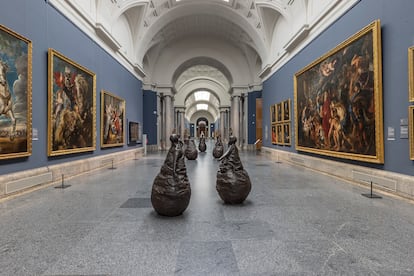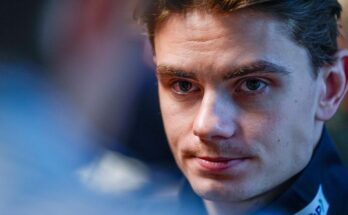If we have come to this great theater of life to learn, experiment, build and play, why not do the same with art, which is nothing more than its reflection and its mirror? Something of the sort must have been thought – we venture – by the Madrid sculptor Juan Muñoz (1953-2001), who returns to his city, and to his oft-visited Prado Museum, in the exhibition art stories (from 18 November to 8 March 2026), an overview divided into different spaces inside and outside the gallery, where his recognizable figures in a hot air balloon, his Asians, the dwarfs and other characters absorbed or petrified in full laughter stage a representation that is at the same time a dialogue with the masters of art of the past and with the spectator himself, a fundamental part of an equation that only oneself can solve.
Full of the spectacularism, irreverence and profound artistic and human vision that characterized the practice of Muñoz, one of the most international Spanish creators of the late 20th century, the exhibition, curated by Vicente Todolí (former artistic director of the IVAM and former director of the Tate Modern in London), explores the voluptuous and cultured relationship that the artist maintained with the great classical masters, especially with regards to the Prado Museum, Goya and Velázquez and, beyond him, the baroque Bernini and Borromini. The entire history of art, from ancient Egypt to the 20th century, interests this artist who studies architecture, engraving and works as a curator, but above all the Renaissance, Mannerism and Baroque. “He said that he is not interested in sculpture, but in painting,” Todolí said at the presentation of the exhibition to the media. “And what I aspired to do was bring the spaces invented by the Renaissance into three dimensions.”
Two years ago, in 2023, two exhibitions opened in Madrid to coincide with what would have been the 70th anniversary of Muñoz, who died suddenly during a holiday in Ibiza in 2001 at the age of 48. If those proposals sought to underline the undeniably contemporary quality of the artist’s gaze, on this occasion, honoring the stage where this type of work is represented performance frozen in time, what we want to highlight is the sculptor’s engulfing drive towards all the art that preceded him. “I can take from the artists of the past what I want and need. I steal what I can from the history of art”, Todolí repeated this phrase of Muñoz. Without forgetting that, with art, he wasn’t just referring to painting or sculpture: poetry, cinema, theatre… everything was used by the Madrilenian to create his realistic worlds, illusory but real, artificial montages where characters embody archetypes and ideas take on inexhaustible and changing forms.

The Prado exhibition is divided into two clearly differentiated sectors: on the one hand, an intimate journey through two rooms of the Jerónimos building dedicated exclusively to the display of his works, where you can see emblematic works such as The pointer OR The nature of visual illusionand another more extravagant one distributed between the exterior, two painting rooms and some stairs of the Villanueva building, where the sculptures integrate into the traditional visit to the museum and chat face to face with the paintings of Rubens or Velázquez. In the first part, that childhood dream seems to come true in which you imagine the world standing still and you can calmly cross it to smell everything: the gestures, the looks, the physiognomies, the landscapes. How did those characters get there? What serendipities were chained together to end up converging at this specific moment? As settings for a silent and immobile work, many installations feature floors reminiscent of trompe-l’oeil, legacies of minimal art that question sensorial perception and give a bombastic air to the scenes in which the figures look out from balconies (a wink to Goya), look at themselves in the mirror (a wink of Velazquez) or balance themselves in a reference to the circus from which Muñoz drank so much.
As for the second part of the exhibition, Muñoz’s figures interacting with the Prado collection represented, as Todolí pointed out, the “most difficult” challenge in assembling this exhibition of intersecting temporal visions. But this Monday, as soon as they settled in, they seemed to have already integrated into the space as if it had always been their home. In the central room there is the evanescent painting by Rubens, one of the most famous Conversation scenes by Muñoz—an installation in which several round-based figures with the same physiognomy, but differentiated gestures, try to communicate (with each other and with us)—already served as inspiration to designers searching for models among the Prado’s masterpieces. In Velázquez’s room, Sara with pool table proposes one of those infinite mirror games that strip away the mimesis of art and life. Sara, the figure of a woman suffering from dwarfism, stands in front of the court dwarves portrayed by Velázquez. He looks at a pool table where some of his drawings and characters are placed Las Meninas where the painter, the true protagonist, can also admire his own reflection.

Like a link in the ring of the intertwining of art and life in the work of Juan Muñoz, or perhaps as a sign of one of his synchronicities, right at the end of the first part of the route, leaving the room, a door of the Jerónimos building opens onto another work of art: one of those rock-vegetal-sculptural formations so recognizable by Cristina Iglesias, Juan Muñoz’s partner, who was also present at the event. presentation. Before leaving that space, the visitor is welcomed by a cabinet of curiosities surrounded by drawings, an artistic genre that Muñoz also cultivated together with others such as performance and the theatre. Filled with figurines, this cabinet is on the one hand proof of the artist’s solemnity and, on the other, of his irreverence: it displays everything from small sculptures to bathroom objects (understanding the cabinet in its meaning of toilet), including knives like the one that Muñoz always carried with him for a season to demonstrate to the world, perhaps even to himself, that what was his would never pass through submission.



